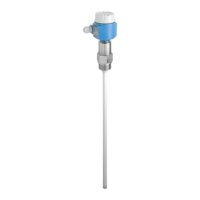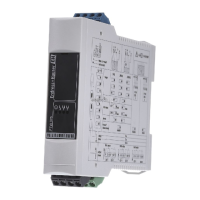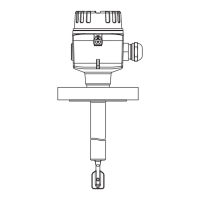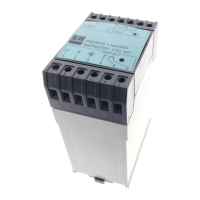6.2 Switch point optimisation
Function After a calibration with uncovered or covered probe (see Section 5.2, 5.3 and 5.4)
the switch point of the FEC 22 can be set either manually (see Section 6.1) or
automatically to adjust to the material being measured.
Caution!
Switch point optimisation operates only with horizontal probes.
Switch point optimisation can be activated after an uncovered or covered probe
calibration has been carried out. The procedure for switch point optimisation is similar
to that for the simultaneous uncovered and covered probe calibrations. The
advantage of this procedure is that the second calibration point does not have to be
determined.
The evaluation electronics calculates the switch point and places it halfway between
the capacitance when empty (C
L
) and the capacitance with probe covered (C
H
).
This optimises the signal-to-noise ratio. Error functions caused by changes in
capacitance due to build-up on the probe or to properties of the material
(conductivity, dielectric constant) are thus minimised.
Switch point
optimisation after
calibration with probe
uncovered
After carrying out a calibration with probe uncovered, the capacitance when empty
C
L
is permanently stored. When the probe is covered, the FEC 22 automatically
determines the capacitance with probe covered C
H
. The switch point C
S
is then
placed halfway between the capacitance when empty C
L
and capacitance when
probe covered C
H
. If the properties of the medium alter and cause a change in the
capacitance C
H
when covering the probe, then this value is updated and the switch
point C
S
adjusted accordingly.
Switch point
optimisation after
calibration with probe
covered
After carrying out a calibration with probe covered, the capacitance with probe
covered C
H
is permanently stored. When the probe is uncovered, the FEC 22
electronic insert automatically determines the empty capacitance C
L
. The switch point
C
S
is then placed halfway between the capacitance when probe covered C
H
and the
capacitance when probe uncovered C
L
. If the properties of the medium alter and
cause a change in the capacitance C
L
when uncovering the probe, then this value is
updated and the switch point C
S
adjusted accordingly.
Switch point difference
∆C for switch point
optimisation
Switch point optimisation can also be activated with another ∆C value besides the
preset value ∆C = 2 pF. If the ∆C value was previously set manually to 4 pF,
then it is adjusted only when the change in capacitance C
X
(see Page 26) is larger
than 2 x ∆C = 8 pF. When de-activating the switch point optimisation, the last
calculated switch point capacitance C
S
is held and the current switch point difference
∆C is shown on the LED chain (rotary switch in Position 1). Changes can then be
made manually.
Cleaning the vessel Caution!
If the vessel and probe are to be cleaned, e.g. CIP, with the switch point optimisation
switched on, then the switch point adjusts to the cleaning solution, provided that it
produces a larger change in capacitance than the process medium. This might
otherwise lead to faulty measurements. In this case switch point optimisation is not
recommended.
Caution!
Caution!
6 Additional Settings Elektronic insert FEC 22
34 Endress+Hauser
